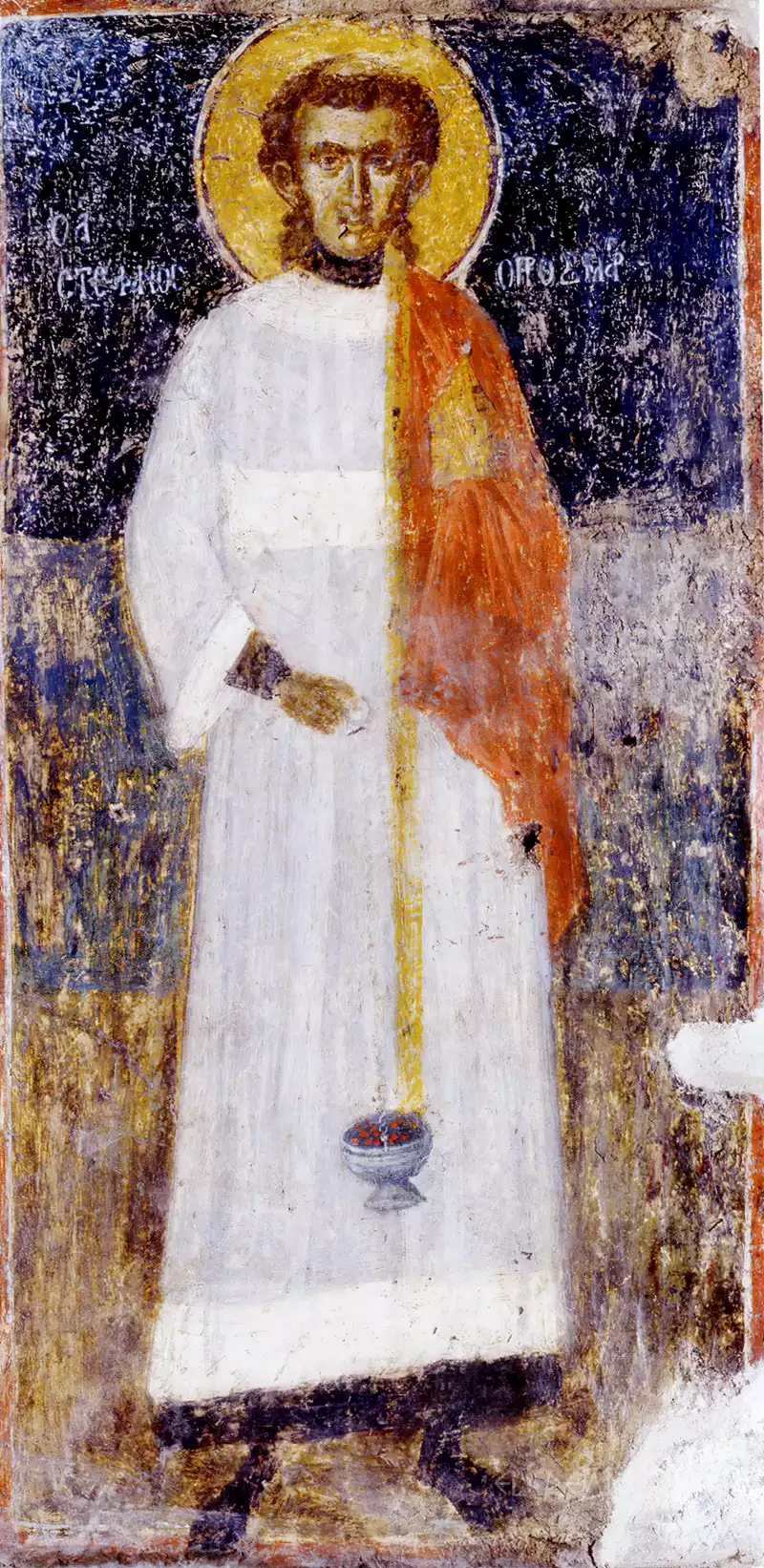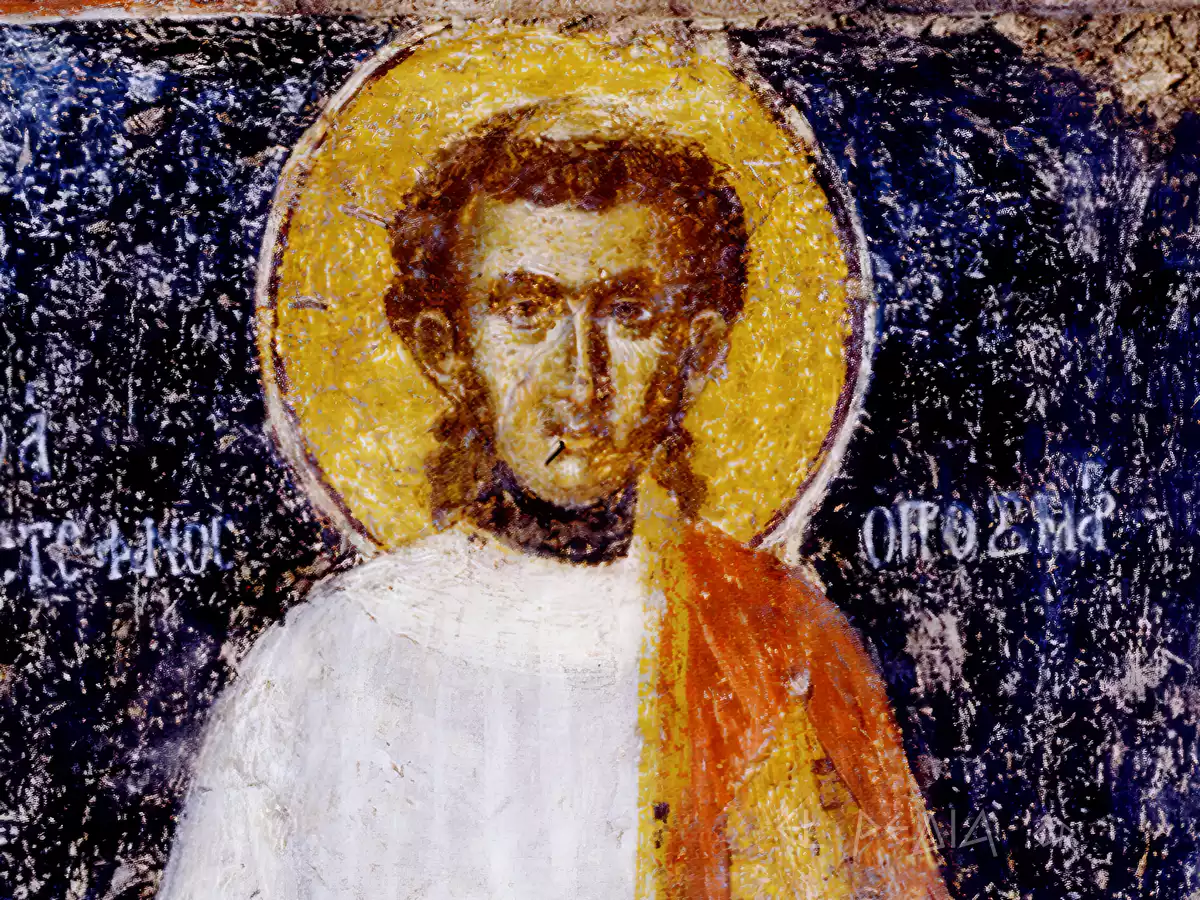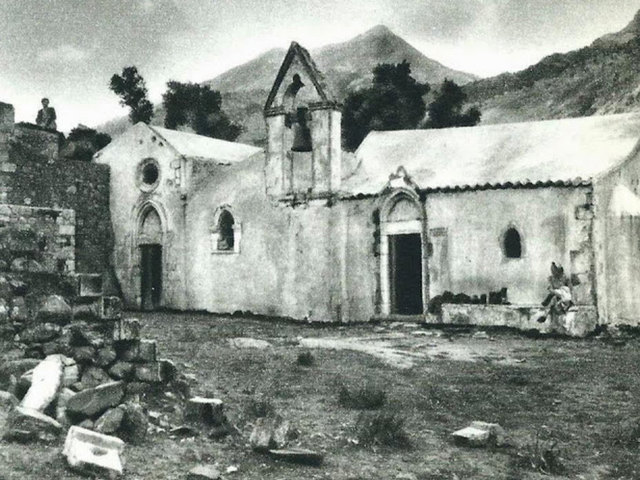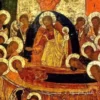
Title: Saint Stephen the Protomartyr
Artist: Unknown
Type: Fresco
Date: Early 15th century
Dimensions: Unknown
Materials: Fresco on plaster
Location: Holy Monastery of Valsamonero, Church of Panagia Odigitria, Crete
The fresco of Saint Stephen is an exceptional example of Byzantine iconography from the early 15th century, adorning the walls of the historic Valsamonero Monastery in Crete. The work depicts Saint Stephen, the first martyr of the Christian faith, in a monumental and imposing stance. The style of the fresco reflects the artistic tradition of the Cretan school, combining Byzantine and Western elements. The unknown artist has masterfully rendered the figure of the Saint, dressed in a white tunic and red mantle, holding the censer symbolizing his diaconal role. The halo around his head indicates his sanctity, while the expression on his face exudes serenity and spirituality.
Artistic Analysis and Style
The fresco of Saint Stephen at the Valsamonero Monastery is an outstanding example of the artistic tradition of the early Cretan school. The figure of the Saint is rendered with monumentality and priestly grandeur, characteristics that reflect his spiritual essence. The unknown artist has used a refined technique in rendering the garments, where the white tunic falls in elegant folds, while the red mantle adds dramatic intensity to the composition.
The technical execution of the fresco reveals an artist with deep knowledge of Byzantine art, who skillfully combines traditional elements with innovative approaches of his time, creating a composition characterized by an exceptional balance between spiritual content and artistic expression (R Cormack).
The color palette of the work, although limited, is used with exceptional skill to convey both the material and spiritual dimension of the depicted Saint. Particularly impressive is the use of gold in the halo, creating a sense of transcendence and divine light, while at the same time the detailed treatment of the facial features reveals the human dimension of the Saint.
In the background of the composition, the artist has used a deep blue color that serves as a symbol of the celestial dome and refers to the spiritual dimension of the depiction, while at the same time creating a strong contrast with the bright colors of the Saint’s garments, further highlighting his figure. This technique, which combines traditional Byzantine iconography with elements of artistic innovation, is characteristic of the early 15th century period when the Cretan school began to form its own distinct identity.
The fresco is in remarkably good condition, allowing us to enjoy the subtle gradations of colors and the artist’s exceptional technique in rendering details. The overall composition is characterized by a harmonious balance between the monumentality required by religious art and the artistic sensitivity that reveals the human dimension of the Saint.

Unveiling the Symbolism and Theological Interpretation of Saint Stephen’s Fresco
The Artistic Narrative and Spiritual Significance
The fresco featuring Saint Stephen at the Valsamonero Monastery presents a rich array of symbols that are deeply linked to the theological understanding of the time. The artistic glory of this work is indicative of the Byzantine tradition, where the divine world and the aesthetic realm find a consummate union. This work is part of the fresco cycle within the Church of Panagia Odigitria, which most historians believe was painted in the early 15th century. The figure of Saint Stephen is placed within the church’s architecture in a way that makes him an essential part of the image’s “theological program.” The figure is not presented in a way that is meant to suggest formlessness or lack of interest; on the contrary, he is presented in an essentially vital manner.
In this main diagram, the depiction of Saint Stephen carries great weight. This charge originates from a dynamic relationship with the viewer that the saint accomplishes. Yes, the moldings of the figure’s posture and the rendering of the facial expression go a long way toward maintaining a connection that at times feels almost contactual, though what we’re really dealing with here is “St. Stephen touch”. The censer, held by the figure, functions much like the incense it contains in that it serves to create a sweet-smelling smoke that wafts in the general direction of the observer. And smell, as we know from our kindergarten lessons in the senses, is a powerful trigger for memory. But more on that in a minute, because there are some very important things to be said about the use of color in this fresco.
The fresco forms one part of the larger collection of murals that decorate the Valsamonero Monastery. It is located near the village of Vorizia, on the lower slopes of the impressive Mount Psiloritis. 1 The monastic complex, which is 53 kilometers from Heraklion, has withstood the test of time, though only the katholikon part of the complex is still standing today. 2 The Valsamonero Monastery is significant for several reasons: its unusual architectural design, the remarkable decorations that adorn the church, the individual talents of the artists who contributed to the murals, and the diverse artistic movements that the murals reflect. All of this makes the monastery a valuable part of the artistic heritage of this region.

Treasure of Byzantine Art
The fresco of Saint Stephen at the Valsamonero Monastery is a remarkable example of the artistic and spiritual legacy of Byzantine art in Crete. The work, dating to the early 15th century, reflects the unique blend of Eastern and Western influences that characterized the Cretan school of that period. The excellent preservation of the fresco allows contemporary scholars to appreciate the high technical skill of the artists of the time.
The monument, located on the southern slopes of Mount Psiloritis, testifies to the flourishing of monasticism in the area during the period of Venetian rule. The artistic value of the work lies not only in its technical perfection but also in the way it combines traditional iconography with innovative elements of its time, creating a unique composition that reflects the spiritual and artistic climate of the era.
elpedia.gr
Bibliography
Cormack, R. Byzantine Art. London: Oxford University Press, 2018.
Delikari, A. From Saint Arsenios and Saint Gregory the Sinaite to the Monasteries of Valsamonero and Lousoudi.” PhD diss., Aristotle University of Thessaloniki, 2019.
Evans, HC, and WD Wixom. The Glory of Byzantium: Art and Culture of the Middle Byzantine Era, AD 843-1261. New York: Metropolitan Museum of Art, 1997.
Faridou, S, and M Giannarou. “Online Inter-School Journeys with Icons.” Issues in Teaching Religion 2 (2019): 171-186.

